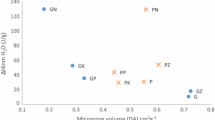Abstract
We studied the adsorption removal of the colored impurities from caprolactam solution by granular activated carbons. It was observed that removal was favored at lower pH (pH 3.84 or below) and higher temperature. The effects of concentration, dosage of activated carbons, contact time have been also reported. Uptake of colored impurities was very rapid in the first 100 minutes and reached equilibrium after 24 h. The batch adsorption kinetics was found to follow the pseudo-second-order model and the rate constants of adsorption for all these kinetic models have been calculated. Three isotherm expressions Langmuir, Freundlich and Trinomial were shown to fit with the experimental results successfully. The mass transfer coefficientβ and the effective diffusion coefficient in aqueous phase Deff was calculated under a temperature 35–80 °C. The value of the mean free energy of adsorption E signifies that the adsorption of colored impurities onto activated carbon has a physical nature.
Similar content being viewed by others
References
Czerwinski, W., Wiejcka, M., Malikowska, H. and Dyjas, S., “Gas chromatographic analysis of impurities in caprolactam,”J. Chromatogr.,208(1), 27 (1981).
Guenter Eppert, Gert Liebscher and Claus Stief, “Examination of organic trace contamination and thermoxidative deterioration of ε-caprolactam by high performance liquid chromatography,”J. Chromatogr.,508(1), 149 (1990).
Jodra, L. G., Romero, A., Garcia-Ochoa, F. and Aracil, J., “Analysis of the impurities in industrial ε-caprolactam hypothesis of formation,”J. Appl. Polym. Sci.,26(10), 3271 (1981).
Jodra, L. G., Romero, A., Garcia-Ochoa, F. and Aracil, J., “Impurity content and quality definition of commercial ε-caprolactam,”Ind. Eng. Chem. Prod. Res. Dev.,20(3), 562 (1981).
Jorge A. Garća Agudo, Maŕ a Teresa Garć a Cubero, “Removal of coloured compounds from sugar solutions by adsorption onto anionic resins: equilibrium and kinetic study,”Separation and Purification Technology,29, 199 (2002).
Kim, S. H., Bidkar, A., Ngo, H. H., Vigneswaran, S. and Moon, H., “Adsorption and mass transfer characteristics of metsulfuron-methyl on activated carbon,”Korean J. Chem. Eng.,18, 163 (2001).
Kim, S. J., Kim, T. Y., Kim, S. J. and Cho, S. Y., “A study of adsorption behavior of 2,4-dichlorophenoxyacetic acid onto various GACs,”Korean J. Chem. Eng.,19, 1050 (2002).
Kim, S. J., Shim, W. G., Kim, T. Y., Moon, H., Kim, S. J. and Cho, S,Y., “Adsorption equilibrium characteristics of 2,4-dichlorophenoxyacetic acid and 2,4-dinitrophenol on granular activated carbons,”Korean J. Chem. Eng.,19, 967 (2002).
Kim, T. Y., Kim, S. J. and Cho, S. Y., “Effect of pH on adsorption of 2,4-dinitrophenol onto an activated carbon,”Korean J. Chem. Eng.,18, 755 (2001).
Kontoyannis, G. G., Bouropoulos, N. Ch. and Koutsoukos, P. G., “Quantitative analysis of impurities in Β-caprolactam by Raman spectroscopy,”Analyst (CambridgeV.K),120(2), 347 (1995).
Malik, P. K., “Dye removal from wastewater using activated carbon developed from sawdust: adsorption equilibrium and kinetics,”Journal of Hazardous Materials B,113, 81 (2004).
McKay, G., Allen, J. S., McConvey, I. L. and Otterburn, M. S., “Transport process in the sorption of colored ions by peat particles,”J. Colloid Int. Sci.,20, 323 (1981).
Mckay, G., “Solution to the homogeneous surface diffusion model for batch adsorption systems using orthogonal collocation,”Chem. Eng. J.,81, 213 (2001).
Mitali Sarkar, Pradip Kumar Acharya, and Bhaskar Bhattacharya, “Modeling the adsorption kinetics of some priority organic polm lutants in water from diffusion and activation energy parameters,”Journal of Colloid and Interface Science,266, 28 (2003).
Namasivayam, C. and Kavitha, D., “Removal of Congo Red from water by adsorption onto activated carbon prepared from coir pith, an agricultural solid waste,”Dyes and Pigments,54, 47 (2002).
Phillip Pendleton and Sophie Hua Wu, “Kinetics of dodecanoic acid adsorption from caustic solution by activated carbon,”Journal of Colloid and Interface Science,266, 245 (2003).
Tony Sarvinder Singh, K. K. Pant, “Equilibrium, kinetics and thermodynamic studies for adsorption of As(III) on activated alumina,”Separation and Purification Technology,36, 139 (2004).
Author information
Authors and Affiliations
Corresponding author
Rights and permissions
About this article
Cite this article
Zhang, H., Yu, P., Yuan, Z. et al. Study of adsorption behavior using activated carbon for removal of colored impurities from 30% caprolactam solution produced by means of SNIA-toluene-technology. Korean J. Chem. Eng. 23, 455–463 (2006). https://doi.org/10.1007/BF02706749
Received:
Accepted:
Issue Date:
DOI: https://doi.org/10.1007/BF02706749




